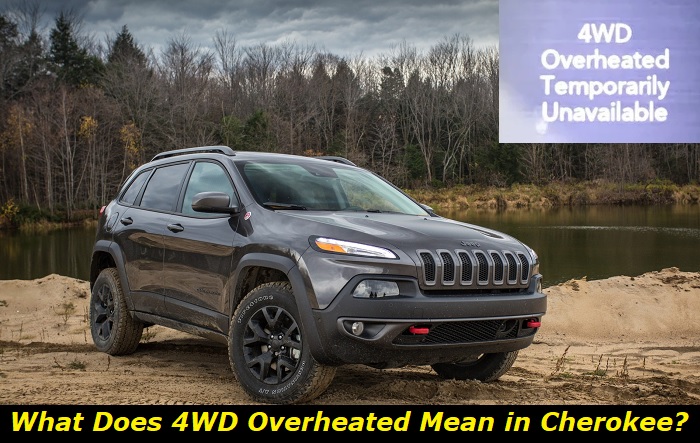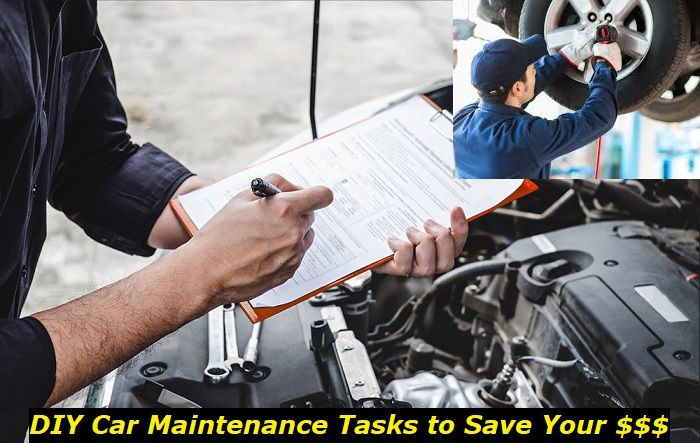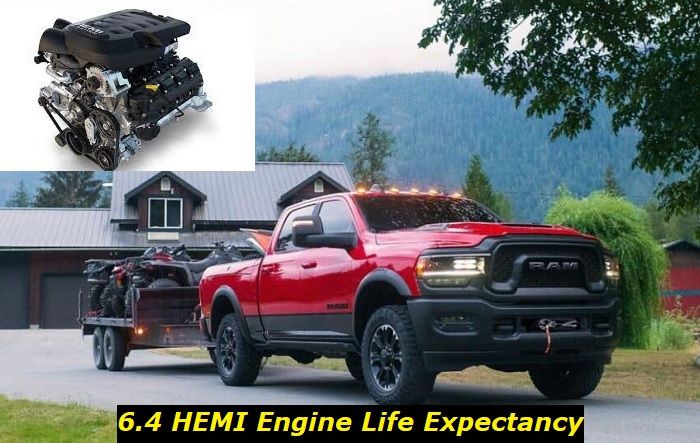If you are driving your Jeep Cherokee and suddenly get some 4WD error message or warning, it certainly doesn't make your mood much better. But you should know that the modern Jeep will have a dozen of possible error messages that may tell you about the problems with the all-wheel-drive system.
4WD overheated, temporarily unavailable highlights
- Common reasons:4WD actuator problems, low differential fluid, faulty sensors
- How to fix:check the fluid in diff, check the 4WD actuator, read the codes
- Possible consequences:differential failure, no 4WD available
- Priority level:High
- Can you drive?Carefully
- DIY repair:Possible but complicated
- Repair price range:$250-$1,500

In this article, I will tell you about the following:
- What may this message mean in your Cherokee?
- Common reasons for this message to pop up.
- What should you do when you see this message?
- Rear diff problems that dealers acknowledge.
- Can you drive with the 4WD Overheated message on the dash?
Let's get started!
What's the meaning of the 4WD Overheated message?
First of all, you should understand that when you see "4WD Overheated, Temporarily Unavailable", the 4-wheel-drive system in your Jeep is not working. It's off for some time - until the message is gone.
Originally, this error message was aimed at controlling the temperature of the differentials and the crankcase to avoid overheating. If the computers got any signs of possible temperature rise, they just commanded the ECU to turn off the 4WD and let you drive using front wheels only.
Of course, if you are in sand or snow at this moment, driving will become complicated or even impossible. So, this message annoys Cherokee owners really much.
But is there a temperature sensor in the differentials of this car? I don't think so. Otherwise, after hundreds or even thousands of reports, Jeep would include some gauge or something else to control the temperature of fluids in crankcase and differentials. But even in 2023, there is no such gauge.
So, I believe that control units use slipping and revving factors to predict possible overheating. And this is a problem because software may glitch and some wrong inputs from some faulty sensors may sometimes trigger this problem wrongly leading to thousands of dollars spent on something that shouldn't be done.
Common reasons to pay attention to
You may be surprised, but there are dozens of reasons why you may see this error message. Unfortunately, when I contacted the Jeep dealership, they told me literally nothing about the common causes and possible solutions for this problem. I spoke to a mechanic in the dealership and he suggested that it's always the problem with the differentials that are a little bit faulty, as he said.
OK, let's see what I could find about this issue:
1) Rear differential problem
Your Jeep Cherokee won't like any kind of load. This is obviously not the vehicle made for towing, digging in sand or mud. The Cherokee will most likely show the "4WD Overheated, Temporarily Unavailable" message because of the issues with the rear differential.
As I understand, this problem is mostly serious in the 2014-2015 Cherokee models and after that, Jeep changed something in their differentials. While it hasn't solved the problem completely, the upgrades obviously made things look better.
Anyway, the Jeep dealership mechanic confirms that in most cases he just replaced the rear differential with the new one and the problem was gone.
If the problem is with the rear diff, you will also most likely see the SVC 4WD warning light on the dash of your car. It may go on immediately or after several minutes.
2) Actual overheating because of abuse
Although I am sure that the differentials in your Jeep Cherokee have no temperature sensors, there is a system of sensors that measures possible slipping and other issues. So, when you rev up the vehicle and abuse it, the clutches in the differentials may not just bear these loads and will eventually fail to do their job.
Immediately, you will see the message about overheating on the dash and will also not be able to use the benefits of the 4WD. Fortunately, after 10-20 minutes of waiting, this problem disappears and the 4WD is back.
3) Weird issues with sensors and control units
If one of the wheel speed sensors is freaking out, the control modules in your vehicle may make the conclusion that the differential is slipping or just isn't working properly. In this case, there is nothing wrong with the 4WD system and you just need to replace the faulty sensor.
Or there may be a problem with some of the control units in terms of software or electrical glitches. Unfortunately, locating this problem is pretty hard and you may need professional help. One more problem is that even specialists may struggle to find the actual reason for the issue.
OBD2 scanners are helpful but you need a proper scanner, not just the $10 one. Good software and a proper scanner that can communicate with all control modules will obviously help, in this case.
What should you do when you see this message?
Now you know why this may happen with your Jeep Cherokee. But how can you solve the problem? You should understand that if you see this message once a year, this is just a reminder that abusing your Cherokee by towing a lot or driving on deep sand or mud is not appropriate - this is not what this car was made for.
If you see the "4WD Overheated" message regularly, there is certainly a problem that has to be solved.
But before you go to the dealership, here are some things you may try doing on your own:
- stop the vehicle and wait for 10-20 minutes, start the car and see if the problem disappeared;
- use your OBD2 scanner and try figuring out any possible code that may trigger this message;
- check if all your transmission modes are working (you can shift from low to high, etc.);
- try changing the transmission modes from normal to snow or to any other to see if this fixes the problem;
- try driving for 10-15 minutes on a normal road with normal speed without overrevving;
- try analyzing your driving style and think about how you may be abusing your Jeep.
The Jeep Cherokee is not an all-mighty car and it won't suit many different things that you may want to use it for. This is a small SUV that's made to carry you and your family members from point A to point B.
You will most likely see some 4WD errors and warnings if you try using it as an off-road vehicle, driving on sand or mud, digging in deep snow, or towing your huge boat or trailer. If this is what you are doing, just change your driving habits and things should be better soon!
But if you can't cope with the problem easily, it's time to go and ask for professional help.
Rear diff problem explained
Well, in 80% of cases, the "4WD Overheated, Temporarily Unavailable" message will pop up exactly when the rear differential says "it's enough". It will last approximately 70-100 thousand miles in normal conditions or up to 40K miles if you demand a lot from it. After that, you may hear some noise or just find a nasty message on the dash.
The rear differential is not that cheap. Even a good aftermarket part will cost you about $1,500 and I couldn't find the price for the OEM as the dealership just didn't want to talk to me.
Anyway, to buy the part is only one half of the problem. Labor will cost you another $1000 or even more than that.
And yes, Jeep acknowledges that these differentials are not made to last forever and there is reportedly an inner bulletin that says if there are problems with 4WD in the Cherokee, the first thing to check is the rear differential. This was said to me unanimously by one of the mechanics I know.
So, in most cases, you will need a new rear differential to get rid of the problem. And don't forget that diffs, transmission, and other parts of your car need fluid replacement. You better change that fluid more often than Jeep recommends!
Can you drive with this message on the dash?
In short, yes, you can drive. The only problem is that your 4WD will not be working. But if you are towing something, driving in deep snow or sand, or trying to get out of mud, it's important to stop your vehicle, let it cool down for a while, and check if you may break some rules and limitations set by Jeep for your car.
Other than that, there is no risk in driving your car on a good road with no trailer attached. After some time of driving, the warning message will be gone and you will get back the ability to use 4WD.
About the authors
The CarAraC research team is composed of seasoned auto mechanics and automotive industry professionals, including individuals with advanced degrees and certifications in their field. Our team members boast prestigious credentials, reflecting their extensive knowledge and skills. These qualifications include: IMI: Institute of the Motor Industry, ASE-Certified Master Automobile Technicians; Coventry University, Graduate of MA in Automotive Journalism; Politecnico di Torino, Italy, MS Automotive Engineering; Ss. Cyril and Methodius University in Skopje, Mechanical University in Skopje; TOC Automotive College; DHA Suffa University, Department of Mechanical Engineering






Add comment